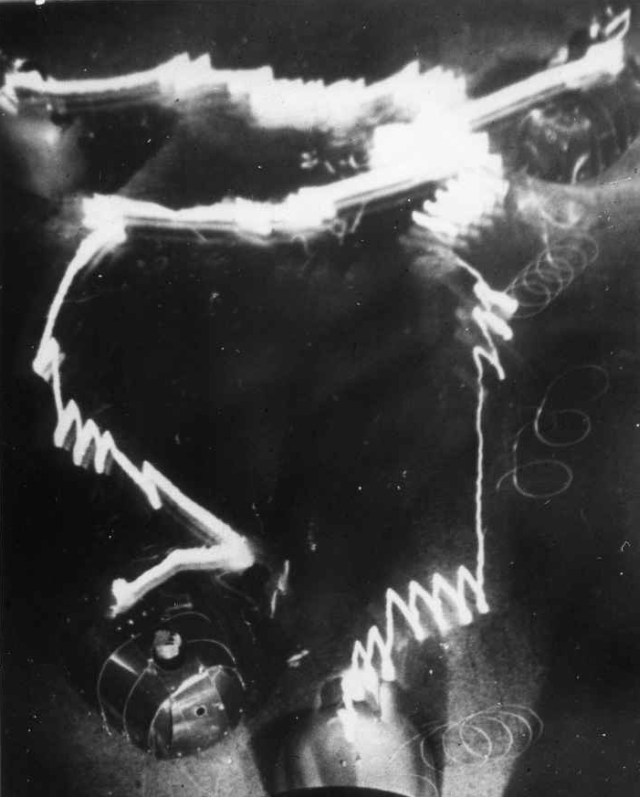I have only come across two time-lapse photographs with both ELMER and ELSIE.
One has to be careful in interpreting time-lapse photographs as there are possibly different events happening at different times, off picture interference, and possibly different start times of each tortoise.
An important observation highlighted by Owen Holland is the direction of rotation of the scan, which is clockwise for ELMER, and counter-clockwise for ELSIE.
This is evident in both of the time-lapse photo’s and the diagrams by Bernarda Bryson (partner and later married to the artist Ben Shahn), as illustrated in Scientific American (Walter, W. Grey, "An Imitation of Life," Scientific American, May 1950, p42-45.).
Let's look at the first photo.

Firstly, we will look at the behaviour of each tortoise individually.
In doing so, it’s important to understand and observe the environment under which the photographic session was filmed under.
Observations to consider:
• Elmer’s trace is a lot heavier than Elsie’s – assuming same sized and intensity lamp/light, this indicates that Elmer is running slower the Elsie.
Pre-conditions:
• Elmer slower than Elsie.
• Candle/Lamp on top/rear of shell.
• Both Tortoises end up at Hutch as if to ‘feed’ – therefore probably the whole time-lapse session is done with both Tortoises in ‘hunger’ mode.
• Hutch light possibly switched off for roughly half the time-lapse sequence.
Elsie:
Appears to travel the first .5 metre or so heading towards Elmer. If Elmer was a lot slower as described in the literature, quite possibly Elmer has had a head start, with somebody behind Elsie holding a torch to bring Elmer to Elsie.
Elsie then is attracted to the light used to highlight Elmer in the opening sequence. Elsie then, after a few sideways moves, heads towards the hutch light. (Maybe this is when the hutch light is switched on?). Although Elmer is slower, he spends less time stuck in patterns than Elsie does. To that extent, his path is a lot shorter, making up for his apparent slowness,
This next time-lapse photo shows ELMER and ELSIE in Grey Walter's lounge room as it appear in Life magazine (May 15, 1950). Recently [2009] Life released the original image of this, which I have reproduced as well. (searchable under google images source:life)
Elsie’s steering mechanism appears to rotate in a clockwise direction. Elmer’s in a counter clockwise direction. Depending where the lamp/light is, one needs to check to see if this isn’t an illusion i.e. the trail of the tortoise re the rear wheels, rather than the scanning direction.
(Note: Although Grey is holding a cigarette in his right hand, there are several pictures of him holding a cigarette in either hand. He normally wears his watch on his left wrist, and you can just see it with his hand in his pocket. His shirt also buttons up the correct male way. All these indicate that the picture has not been printed in reverse, which could have explained the trajectory taken. As an aside, notice that Grey's feet have been 'lost' as a result of the double exposure.)
The most probable explanation is as follows:
As per most of the known traces, Elmer and/or Elsie are always photographed at the beginning of a trace. Obviously where they appear twice, only then are we seeing the tortoises at both ends of the sequence.
Therefore, to contradict the caption, Elmer and Else are pictured at the start of the sequence, and are moving away from the fire. There were probably torches outside of the camera's view guiding their path.
I know you’re not convinced yet, but the clincher is that if Elsie was to cycle in the apparent direction with its clockwise motion, then, as proven with the replica I have seen, Elsie would then creep to the left, and not to the right as shown.
So now knowing that information, it all falls into place.